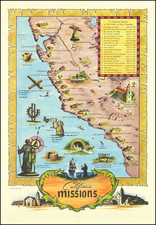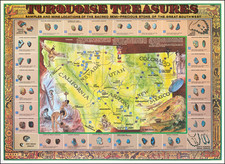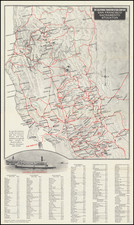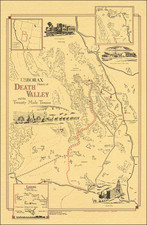This Elegant Beach and Townsite Are Located in San Luis Obispo County -- The First Map of Grover Beach, California.
Rare promotional map, view of the Town of Grover and Huntington Beach, in San Luis Obispo County, published by The Carnal-Hopkins Company and Russell & Cerf, lithographed in San Francisco by Dakin Publishing Company.
The map includes a lengthy promotional text on the verso, along with a regioinal map of part of San Luis Obispo County and a striking coastal view.
Grover Beach was originally known as Town of Grover, which was founded on August 1, 1887. After a single real estate auction in 1887, the promoters would fail in their further efforts and the townsite would be sold to new developers in January 1894. The new promoters published this map and promotional broadside. This promotional item was likely issued in the same year and may be the oldest extent illustrated promotional map for the town.
Huntington Beach was selected as a means of luring the Southern Pacific to put a station in Grover. However, but the mid-1890s, the name would be changed to Pismo Beach. In a later edition of the smaller map on the verso of our map (Map Showing the Town of Grover, Huntington Beach and surroundings . . .), the name Huntington Beach is changed to Pismo Beach (see third image).
Grover / Huntington Beach
The following is drawn from Mark Hall-Patton's article in the South County Tribune in February 4, 1993:
In 1887, Southern California was experiencing an unprecedented boom in real estate values. At the height of the boom, land values in some areas were doubling monthly. [South San Luis Obispo] County was not immune to the excitement, and many new communities were laid out in anticipation of hordes of new residents. Many new developments were promoted, each hoping to be in on the next big community.
The boom was fueled by a rate war between the Santa Fe and the Southern Pacific railroads. At its height on March 6, 1887 the cost of a ticket from Kansas City to Los Angeles was lowered to $1.00. Though fares quickly went back up they stayed much lower than they had been, and thousands of new immigrants flocked to California.
Among the developers who hoped to cash in on the influx of new settlers was a 35-year-old Santa Cruz native who was involved in many promotions. One, though, he decided to name for himself. It was to be a beachfront community with wide boulevards, a train station for the eagerly awaited Southern Pacific Railroad, a resort hotel and many hundreds of residents. This was the dream of Dwight W. Grover. Grover was also involved in the founding of Templeton, and the expansion of Nipomo, and the founding of Los Alamos. But it was not until he and George Gates purchased land from John M. Price and Adam Spath, that grover developed a community he named for himself.
The new community seemed to have everything going for it. It was the height of the boom. Grover and Gates had the community laid out with broad streets named for famous worldwide resorts. The grand hotel was started by a Mr. Laird. a retail liquor store was started by Adam Spath, who had sold Grover and Gates part of the property, and a grand auction was held.
The initial offering was a great success, with $15,000 paid for 133 lots on the first day and an additional $7,500 for 75 lots on the second. The future looked rosey for the new town. Unfortunately, this was not to be the case. Grover and Gates were counting on the arrival of the Southern Pacific to help their new community grow. The SP however, stopped at Santa Margarita in 1889 and did not make it to San Luis Obispo until 1894. In 1895 it finally made it through Grover–without stopping.
The SP got a better deal in Oceano, and located its depot there. Before this, in 1888, California experienced the worst bust in its history. Land values plummeted on a scale that up to that time had been unimaginable. Many developers and promoters of new communities and subdivisions, including Grover and Gates, were caught with land that was worth a fraction of what they paid for it. Grover and Gates, while losing their interest in Los Alamos and Nipomo, managed to hold onto their property at the Town of Grover for a few years. They left the area, but continued to sell a few lots now and then.
Many local businessmen had purchased land in the new town, and some continued to do so. Aron and Alexander, merchants from Arroyo Grande, and C.L. St. Clair, an news stand and tobacco dealer from San Luis Obispo, were among those who purchased lots in the new town after 1890. In 1893, Grover returned to his namesake community to try to promote it a second time. His timing again was bad, though as that was the year of one of the worst depressions of the 19th century. After this last attempt Grover sold out.
On Jan. 23 1894, The unsold property in the Grover Townsite, about 1,000 acres in total had new owners. Charles J. Russell, Moses Cerf and a Mr. Mowry, purchased D.W. Grover’s interest in his namesake community. They felt they would be more successful than Grover and Gates, and had quite a promotional effort in mind.
A bird’s eye artist’s view of the community was commissioned and printed for distribution to prospective buyers. The beach, which had heretofore been known as part of the great Pismo Beach, was renamed where it abutted the townsite. Henceforth this part of the beach was to be known as Huntington Beach. The Tribune described the new view in an article in its July 25, 1893, issue:
Yesterday, Mr. C.J. Russell handed us one of the early proofs of a new picture, a lithographed bird’s eye view of the bay of San Luis Obispo and its surroundings…We think the object has been quite well attained and concur in the endorsement given the view by a great number of the principal citizens of this city and Arroyo Grande. The lithograph is obviously gotten up in the interests of the projected town of Grover, and the surrounding country is laid down with reference to that town.
The train was coming and everything seemed poised for success again. By 1895, John Dockery started running a stage line to Grover, in addition to the Pismo Beach and Arroyo Grande. Russell, Cerf and Mowry were probably congratulating themselves on a job well done, expecting great things of their community. However as we already know, the train bypassed Grover. The community failed to grow as anticipated, though a few sales did continue to occur. The end of the century brought the townsite back on the market.
Ernest Cerf became involved on December 29, 1891, when D. W. Grover and his wife transferred around 1,000 acres known as the Grover and Gates Tract to Nathan P. Carnall of San Francisco and C. J. Russell and Ernest Cerf of San Luis Obispo for the sum of $1. The deed specifies that grantees would act as agents to sell lots in the town within three years. The proceeds of sale would be divided as follows: 60 percent for mortgage and interest, 25 percent toward the sum of $40,000 due D. W. Grover, and the remaining 15 percent (plus any amount of 25 percent over $40,000 due D. W. Grover) is split 2/10 to D. W. Grover, 3/10 to Russel, 3/10 to Cerf, and 2/10 to Carnall.
An article in The Tribune reads: "On the first day of July, 1892, lots were advertised for sale in the new town of Grover located at Huntington Beach. 'It is a fact disputed by none,' the town's promoters wrote, 'that this is the finest beach on the coast, and it is the first point where the Southern Pacific Coast (planned) route . . . touches the beach.' The town of Grover was laid out with lots 100 by 120 feet on a slightly elevated sandy plain sloping toward the beach. With nothing built up between the town site and the water, every lot seemed to offer an open view."
It seems that the original sale did not go well. Moreover, once the Railroad decided not to locate a station in Grover, the need for the name "Huntington Beach" had passed and name "Pismo Beach" would shortly thereafter replace it in the promotional literature, as noted by the third illustration provided herein. Rarity
We were unable to locate any other examples of the map.












![[Stockton] Map of the Property of the Stockton City Homestead Association, Surveyed February 1869](https://storage.googleapis.com/raremaps/img/small/83391.jpg)

![[The 5 Californias] Carte de la Californie Suivant 1. La Carte manuscrite de l'Amerique de Mathieu Neron Pecci olen dressee a Florence en 1604, 2. Sanson 1656 . . .](https://storage.googleapis.com/raremaps/img/small/97983.jpg)

